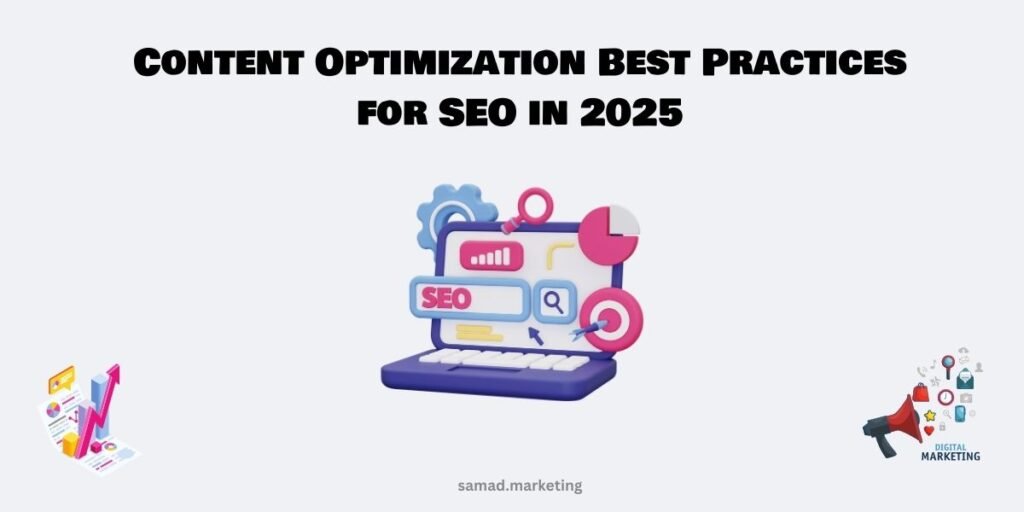Publishing content online is easy. But getting that content to rank, generate traffic, and convert visitors? That takes smart optimization.
In 2025, content optimization is no longer about keyword stuffing or tricks. It’s about creating helpful, relevant, and high-quality content that meets user intent and satisfies search engine requirements.
In this blog post, we’ll walk you through the best practices for content optimization in 2025, broken down into simple, actionable steps.
✅ What Is Content Optimization?
Content optimization is the process of improving your content so that it:
- Ranks better in search engines
- Attracts more organic traffic
- Engages users and drives conversions
It involves fine-tuning various elements such as:
- Keywords
- Structure
- Meta tags
- Internal links
- User experience (UX)
🔍 Why Is Content Optimization Important?
Even great content can fail if it’s not optimized properly.
Optimization helps search engines:
- Understand the topic of your content
- Match it with the right user queries
- Trust it enough to rank it high
And it helps users by:
- Making content easier to read and navigate
- Providing direct answers to their questions
- Improving load speed and usability on all devices
🧠 10 Best Practices for Content Optimization in 2025
1. Start with Search Intent
Before writing, ask:
What is the user really looking for when they search this keyword?
Types of intent:
- Informational: Looking for answers or guides
- Commercial: Researching before buying
- Transactional: Ready to make a purchase or take action
Your content format (blog post, landing page, video) should match that intent.
2. Use Keywords Smartly
Don’t over-optimize. Instead:
- Use the main keyword in the title, URL, and first paragraph
- Include semantic and related terms (LSI-style keywords)
- Use natural language and avoid keyword stuffing
Example:
Main keyword: “local SEO”
Related terms to include: Google Business Profile, citations, local rankings, proximity
3. Write a Compelling Title Tag and Meta Description
These are what users see in search results, so make them count.
- Title tag: Under 60 characters, includes main keyword
- Meta description: 140–160 characters, persuasive and clear
Make users want to click.
4. Optimize for Featured Snippets
To earn the featured snippet (position zero), answer key questions in a clear, concise format.
Tips:
- Use bullet points, numbered lists, or short paragraphs
- Include the question as a subheading (e.g., H2)
- Provide a direct answer below the heading
5. Use Headers to Structure Your Content
Break your content into clear sections using:
- H1 for the main title (used once)
- H2 for key sections
- H3 for subsections
This helps both users and Google scan your content easily.
6. Add Internal and External Links
- Internal links: Link to other relevant blog posts and pages on your site
- External links: Cite credible sources (studies, news, expert guides)
This builds trust and improves crawlability.
7. Use Images and Visuals
Images make content more engaging and easier to understand.
- Use original images, charts, or infographics
- Add alt text with relevant descriptions
- Compress images to improve page speed
Don’t forget accessibility, alt text helps visually impaired users too.
8. Improve Readability
Make your content easy to read:
- Use short paragraphs (2–3 sentences)
- Break up text with headings, lists, and visuals
- Use simple language (aim for 6th–8th grade reading level)
- Avoid jargon unless your audience is technical
Tools like Hemingway Editor or Grammarly can help.
9. Optimize for Mobile and Page Speed
Most users are on mobile. If your content loads slowly or looks bad on small screens, you lose rankings.
Tips:
- Use a responsive design
- Optimize images and code
- Minimize pop-ups and distractions
Use Google’s PageSpeed Insights and Mobile-Friendly Test tools to check performance.
10. Add Schema Markup
Schema helps search engines better understand your content and show rich results (like star ratings or FAQs).
Use schema for:
- Articles
- FAQs
- Reviews
- Products
- How-to content
You can add it manually or with plugins like Rank Math or Yoast SEO.
✍️ Bonus Tip: Refresh Old Content
Keep your old content optimized by:
- Updating outdated information
- Adding new sections
- Improving internal links
- Re-optimizing meta tags
Freshness is a ranking factor.
🧭 Final Thoughts
In 2025, content optimization focuses on creating content that is useful, relevant, and engaging for both search engines and users. It’s not about tricking the system anymore.
Follow these best practices to:
- Improve your organic visibility
- Attract more traffic
- Boost engagement and conversions
Great SEO content is not just optimized, it’s valuable, structured, and user-focused.

